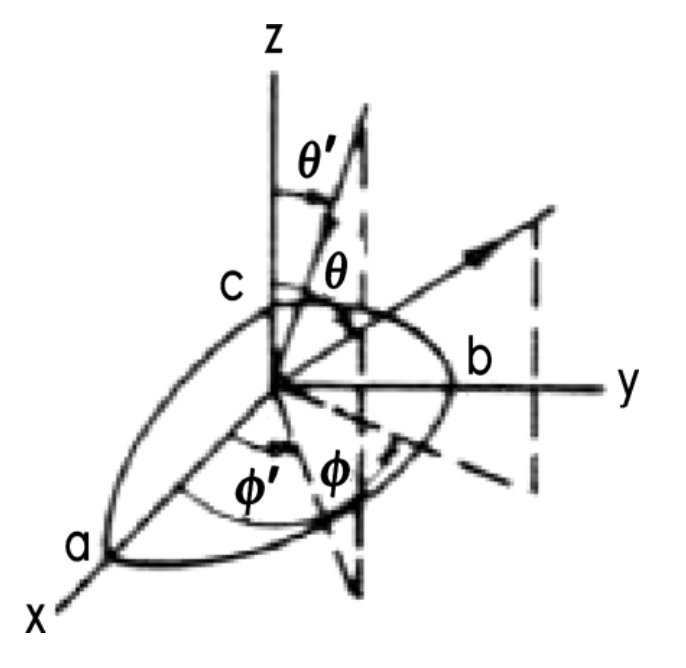Notes for Bistatic Radar Cross Section (RCS)
Contents
Radar Cross Section
This document records some possible useful rcs-related equations for my simulations 😄.
RCS Definition1
The RCS represents an equivalent aperture surface area of the target, which captures a certain amount of incident radiation, and which, if re-radiated isotropically, would produce an equivalent scattered field at the receiver.
For 2d target:
\[\begin{aligned} \sigma_{2d}=\begin{cases}\lim_\limits{\rho \to \infty}\left[2\pi \rho \frac{S^s}{S^i}\right]\\ \lim_\limits{\rho \to \infty}\left[2\pi \rho \frac{|E^s|^2}{|E^i|^2}\right]\\ \lim_\limits{\rho \to \infty}\left[2\pi \rho \frac{|H^s|^2}{|H^i|^2}\right] \end{cases} \end{aligned}. \]
For 3d target:
\[\begin{aligned} \sigma_{3d}=\begin{cases}\lim_\limits{r \to \infty}\left[4\pi r^2 \frac{S^s}{S^i}\right]\\ \lim_\limits{r \to \infty}\left[4\pi r^2 \frac{|E^s|^2}{|E^i|^2}\right]\\ \lim_\limits{r \to \infty}\left[4\pi r^2 \frac{|H^s|^2}{|H^i|^2}\right] \end{cases} \end{aligned}. \]
Where \(\rho,r=\) distance from target to observation point.
- \(S^s,S^i=\) scattered, incident power density.
- \(E^s,E^i\) = scattered, incident electric fields.
- \(H^s,H^i=\) scattered, incident magnetic fields.
Monostatic and Bistatic RCS
Assuming a spherical coordinate system defined by \((\rho,\theta,\phi)\), denote the incident wave direction as \((\theta^i,\phi^i)\) and scattered wave direction as \((\theta_s,\phi_s)\).
- RCS measured by \(\theta_s=\theta_i\) and \(\phi_s=\phi_i\) is called monostatic RCS (or backscattered RCS).
- RCS measured by \(\theta_s \neq \theta_i\) and \(\phi_s \neq \phi_i\) is called bistatic RCS.
Remark: In my opinion, monostatic RCS could be considered as a function of frequency and incident angles while bistatic RCS is more complex and can be considered as a function of frequency, incident angle, scattered angle, and bistatic angle.
Monostatic to Bistatic Equivalence2
Kell’s Monostatic-to-Bistatic Theorem3
\[\sigma_{bistatic}(\theta=\beta,f)=\sigma_{monostaic}(\theta=\beta/2,f \sec(\beta/2)). \]
Crispin’s Monostatic-to-Bistatic Equivalence Theorem4:
\[\sigma_{bistatic}(\theta=\beta,f)=\sigma_M(\theta=\beta/2,f). \]
Here, \(\beta\) refers to bistatic angle and \(f\) refers to frequency.
Bistatic RCS Estimation of an ellipsoid5 6

Considering an ellipsoid with its center at the origin:
\[\frac{x^2}{a^2}+\frac{y^2}{b^2}+\frac{z^2}{c^2}=1, \]
where, \(a\),\(b\),\(c\) represent the length of the three semi-axes of the ellipsoid in the \(x\), \(y\), \(z\) directions respectively.
Denote the incident and scattered wave directions in spherical coordinate form as \((\theta_i,\phi_i)\) and \((\theta_s,\phi_s)\) respectively. Here, \(\theta_i,\theta_s\) refer to the incident and scattered aspect angles while \(\phi_i\), \(\phi_s\) refer to the incident and scattered azimuth angles of the ellipsoid relative to the transmitter and receiver.
- Then the bistatic RCS could be estimated by:
\[\sigma_{bistatic} = \frac{4\pi a^2b^2c^2[(1+\cos \theta_i\cos\theta_s)\cos(\phi_s-\phi_i)+\sin\theta_i\sin\theta_s]^2}{\left[a^2(\sin\theta_i\cos\phi_i+\sin\theta_s\cos\phi_s)^2+b^2(\sin\theta_i\sin\phi_i+\sin\theta_s\sin\phi_s)^2+c^2(\cos\theta_i+\cos\theta_s)^2\right]^2}. \]
- For monostatic case (\(\theta_i = \theta_s=\theta\), \(\phi_i = \phi_s=\phi\)), we have:
\[\sigma_{monostatic}=\frac{\pi a^2b^2c^2}{[a^2\sin^2\theta\cos^2\phi+b^2\sin^2\theta\sin^2\phi+c^2\cos^2\theta]^2}. \]
- When \(a=b=c=r\), we have rcs estimation of a sphere:
\[\sigma_{monostatic-sphere}=\pi r^2. \]
Radar Range Equation
Bistatic radar range equation:
\[P_r=\frac{P_tG_tG_r\sigma_B\lambda^2}{(4\pi)^3R^2_{Tx}R^2_{Rx}}. \]
Monostatic radar range equation (\(R_{Rx}=R_{Tx}=R\)):
\[P_{r}=\frac{P_{t}G_tG_r \sigma_{M} \lambda^2}{(4\pi)^3R^4}. \]
Where:
- \(P_t\), \(P_r\) refer to transmit and receive power.
- \(G_t\), \(G_r\) refer to transmit and receive antenna gain.
- \(\sigma_B\) and \(\sigma_M\) refer to bistatic and monostatic RCS.
- \(R_{Tx}\), \(R_{Rx}\) refer to distance of transmitter-target and receiver-target.
Balanis, Constantine A. Advanced engineering electromagnetics. John Wiley & Sons, 2012. ↩︎
Eigel Jr, Robert L. “Bistatic radar cross section (RCS) characterization of complex objects.” (1999). ↩︎
Kell, Robert E., “On the Derivation of the Bistatic RCS from Monostatic Measurements,” Proceedings of the IEEE. Vol XX No Y: 983-988, Aug 1965. ↩︎
Cispin, J. W. and Siegel, K. M. Methods of Radar Cross Section Analysis. New ↩︎
Radar Cross Section Handbook. United States, Plenum Press, 1970. ↩︎ ↩︎
K. D. Trott, “Stationary Phase Derivation for RCS of an Ellipsoid,” in IEEE Antennas and Wireless Propagation Letters, vol. 6, pp. 240-243, 2007, doi: 10.1109/LAWP.2007.891521. ↩︎ ↩︎